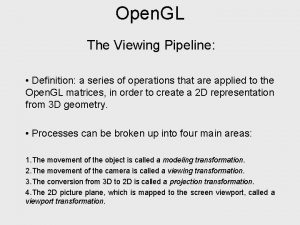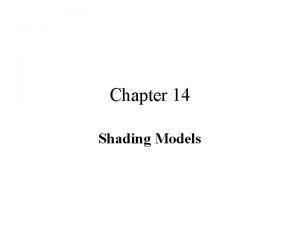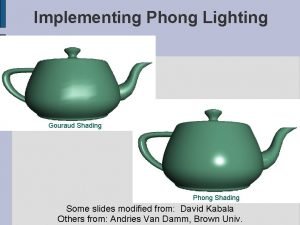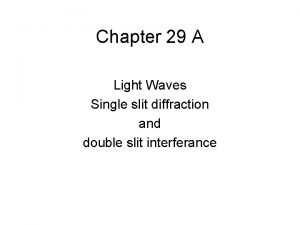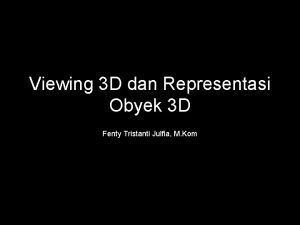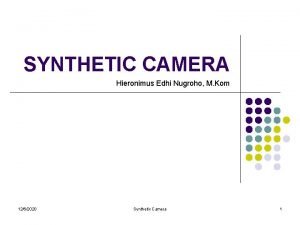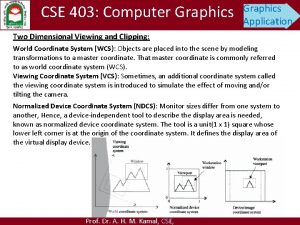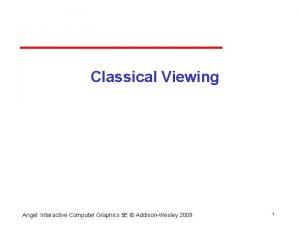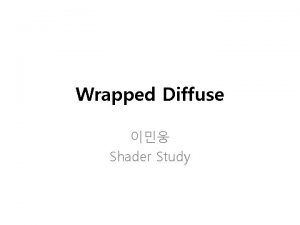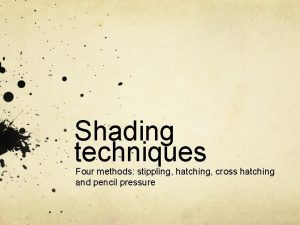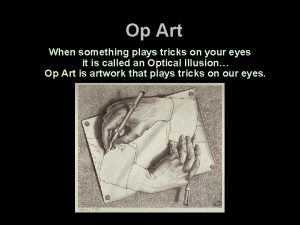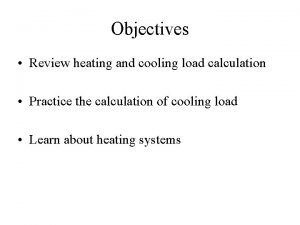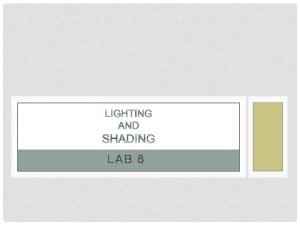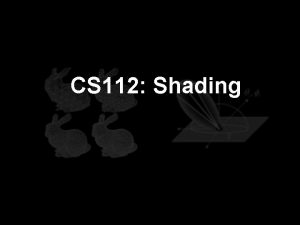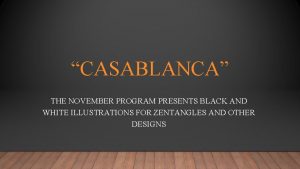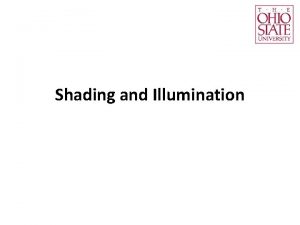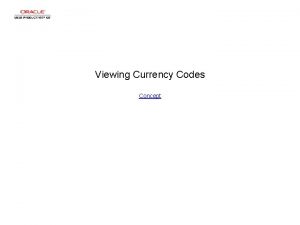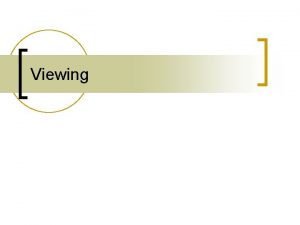Chapter 14 Shading Models 3 D Viewing Pipeline




































- Slides: 36

Chapter 14 Shading Models

3 D Viewing Pipeline Primitives Object space Modeling Transformation World space Viewing Transformation Camera space Hidden Surface Removal Lighting & Shading 3 D-Clipping Projection Normalized view space Scan conversion, Hiding 18 May 2021 Computer Graphics Image space, Device coordinates 2

Viewing Models Need for different models • Light Models: To take care of Light, its intensity and effect on different textures. • Shading Models: To take care of type of surface – its shape, texture etc. and rendering the intensity at every point of the surface. • Colour Models: Various colour schemes present to represent the calculated intensities on your computer. 18 May 2021 Computer Graphics 3

Shading Models • Shading Models: We have an illumination model for given point on a surface and every point on the surface is unique. • Should we calculate intensity of light at all points of the object? • If our surface is defined as mesh of polygons, which point should be used? 18 May 2021 Computer Graphics 4

Shading Models • Keep in mind: – It’s a fairly expensive calculation Several possible answers, each with different implications for the visual quality of the result • Three common techniques are – – Constant shading (No Shading) Faceted shading Gouraud shading Phong shading • Shading models dictate how often the color computation is performed. 18 May 2021 Computer Graphics 5

SHADING METHODS POLYGON RENDERING METHODS CONSTANT SHADING FACETED SHADING Is used for objects defined as No Shading polyhedral. INTERPOLATION SHADING Used for polyhedron-mesh approximation of curved surfaces GOURAUD SHADING Interpolate intensity 18 May 2021 Computer Graphics PHONG SHADING Interpolate surface normal 6

CONSTANT SHADING Effects of different shading techniques FACETED SHADING INTERPOLATION SHADING GOURAUD SHADING 18 May 2021 Computer Graphics PHONG SHADING 7

OBJECT MODEL Effects of different shading techniques FACETED SHADING INTERPOLATION SHADING GOURAUD SHADING 18 May 2021 Computer Graphics PHONG SHADING 8

Shading Models • We will start to look at shading or rendering methods commonly used in computer graphics – Constant surface shading/rendering – Faceted surface shading/rendering – Gouraud surface shading/rendering – Phong surface shading/rendering 18 May 2021 Computer Graphics 9

Contents 1. 2. 3. 4. Constant Intensity Shading Faceted Shading Gouraud Shading Phong and Fast Phong Shading

Constant Intensity Shading • • Constant intensity shading also refer to as no shading. It is done by giving same color to every polygon in the object. Thus entire object is painted with the same color. It is the simplest, but not realistic. 18 May 2021 Computer Graphics 11

Contents 1. 2. 3. 4. Constant Intensity Shading Faceted Shading Gouraud Shading Phong and Fast Phong Shading

Faceted Shading • Also known as flat shading or fast shading it is an extension to Constant intensity shading. • The entire object is divided into number of polygons surfaces called facets. • Determine the orientation of each facet and does one color computation for each polygon or facet. • It is simple, fast (? ) and produce better results than no shading. 18 May 2021 Computer Graphics 13

Faceted Shading Original Faceted Shaded • Just add lots and lots of polygons – however, this is SLOW! 18 May 2021 Computer Graphics 14

Faceted Shading • Still it is not realistic as – For point sources, the direction to light varies across the facet – For specular reflectance, direction to eye varies across the facet • We have to determine the orientation of each facet we have to find the normal for each facet. This approximation effect the result. 18 May 2021 Computer Graphics 15

Faceted Shading • To determine the orientation of each facet we introduce vertex normal at each vertex – Usually different from facet normal – Used only for shading – Think of as a better approximation of the real surface that the polygons approximate 18 May 2021 Computer Graphics 16

Faceted Shading • Vertex normals may be – Approximated by averaging the normals of the facets that share the vertex – Provided with the model 18 May 2021 Computer Graphics 17

Faceted Shading • It is very useful for quickly displaying the general appearance of surfaces • It is more applicable when – the object must be polyhedron and not an approximation of an object with a curved surface. – All light sources illuminating the object are sufficiently far from the surface so that N. L and the attenuation functions are constant over the surface. – The viewing position is sufficiently far from the surface so that V. R is constant over the surface. 18 May 2021 Computer Graphics 18

Contents 1. 2. 3. 4. Constant Intensity Shading Faceted Shading Gouraud Shading Phong and Fast Phong Shading

Gouraud Shading • Gouraud surface shading was developed in the 1970 s by Henri Gouraud while working at the University of Utah along with Ivan Sutherland David Evans • Often also called intensity-interpolation surface rendering • This is the most common approach – Intensity levels are calculated at each vertex – Linearly interpolate the resulting colors over faces • Along edges • Along scanlines 18 May 2021 Computer Graphics 20

Gouraud Shading • To render a polygon, Gouraud surface rendering proceeds as follows: 1. Determine the average unit normal vector at each vertex of the polygon 2. Apply an illumination model at each polygon vertex to obtain the light intensity at that position 3. Linearly interpolate the vertex intensities over the projected area of the polygon 18 May 2021 Computer Graphics 21

Gouraud Shading Step 1: Determine the average unit normal vector at each vertex of the polygon • The average unit normal vector at v is given as: N 1 Nv v N 4 N 2 • or more generally: N 3 18 May 2021 Computer Graphics 22

Gouraud Shading Step 2: Apply an illumination model at each polygon vertex I 2 N 1 I 1 Nv N 4 I v • You have to apply the illumination model to take of N 2 – – ambient light Diffuse reflection Specular reflection Transparency (Refraction) N 3 I 3 18 May 2021 Computer Graphics 23

Gouraud Shading Step 3: Linearly interpolate the vertex intensities over the projected area of the polygon along edges and along scan lines y 3 1 Scan-line 4 p 5 2 18 May 2021 Computer Graphics x 24

Gouraud Shading Original 18 May 2021 Computer Graphics Gouraud Shaded 25

Gouraud Shading • Objects shaded with Gouraud shading often appears dull, chalky • Lacks accurate specular component – If included, will be averaged over entire polygon C 1 C 3 C 2 18 May 2021 Can’t shade that effect! Computer Graphics 26

Gouraud Shading • Gouraud shading can introduce anomalies known as Mach bands • Mach banding – Artifact at discontinuities in intensity or intensity slope C 1 C 4 C 3 C 2 18 May 2021 Computer Graphics Discontinuity in rate of color change occurs here 27

Contents 1. 2. 3. 4. Constant Intensity Shading Faceted Shading Gouraud Shading Phong and Fast Phong Shading

Phong Shading • A more accurate interpolation based approach for rendering a polygon was developed by Phong Bui Tuong • Basically the Phong surface rendering model interpolates normal vectors instead of intensity values and then compute the actual intensity value using Phong Lighting Model. • Often also called normal or vector – interpolation surface rendering 18 May 2021 Computer Graphics 29

Phong Shading • Phong shading is not the same as Phong lighting, though they are sometimes mixed up – Phong lighting: the empirical model we’ve been discussing to calculate illumination at a point on a surface – Phong shading: linearly interpolating the surface normal across the facet, applying the Phong lighting model at every pixel 18 May 2021 Computer Graphics 30

Phong Shading • To render a polygon, Phong surface rendering proceeds as follows: 1. Determine the average unit normal vector at each vertex of the polygon 2. Linearly interpolate the vertex normals over the projected area of the polygon 3. Apply an illumination model at positions along scan lines to calculate pixel intensities using the interpolated normal vectors 18 May 2021 Computer Graphics 31

Phong Shading • Interpolating Normal N 3 N 1 N 4 p Np Scan line N 5 N 2 18 May 2021 Computer Graphics 32

Phong Shading • Phong shading accept the same input as Gouraud shading and produce very smooth-looking results. • Phong shading is considerably more expensive. • Phong shading is much slower than Gouraud shading as the lighting model is revaluated so many times • However, there are fast Phong surface rendering approaches that can be implemented iteratively. 18 May 2021 Computer Graphics 33

Phong Shading Examples 18 May 2021 Computer Graphics 34

Phong Shading Examples 18 May 2021 Computer Graphics 35

Summary • For realistic rendering of polygons we need interpolation methods to determine lighting positions • Flat shading is fast, but unrealistic • Gouraud shading is better, but does not handle specular reflections very well • Phong shading is better still, but can be slow 18 May 2021 Computer Graphics 36
 Viewing pipeline
Viewing pipeline Constant intensity shading
Constant intensity shading Gouraud vs phong shading
Gouraud vs phong shading Linear and nonlinear pipeline
Linear and nonlinear pipeline Paralleism
Paralleism Modals and semimodals
Modals and semimodals Kinds of claim
Kinds of claim Full section vs half section
Full section vs half section Film as text
Film as text Ls&s low vision
Ls&s low vision For viewing tiny objects in a microscope diffraction is
For viewing tiny objects in a microscope diffraction is Thank you for viewing my presentation
Thank you for viewing my presentation Steps in viewing
Steps in viewing Soal dan jawaban grafika komputer
Soal dan jawaban grafika komputer Viewing coordinate sering juga disebut
Viewing coordinate sering juga disebut Narmeen is viewing the board in the classroom
Narmeen is viewing the board in the classroom Define projection in computer graphics
Define projection in computer graphics Lcd working principle ppt
Lcd working principle ppt In two dimensional viewing system have
In two dimensional viewing system have Interior and exterior clipping in computer graphics
Interior and exterior clipping in computer graphics While viewing a slide of rapidly moving sperm cells
While viewing a slide of rapidly moving sperm cells Ground viewing driving
Ground viewing driving Viewing angel
Viewing angel Stupid spherical harmonics (sh) tricks
Stupid spherical harmonics (sh) tricks Tonal shading definition
Tonal shading definition Arsir bayangan
Arsir bayangan Nvidia slang
Nvidia slang 8 shading techniques
8 shading techniques Op art
Op art Shading coefficient
Shading coefficient Shading ms word
Shading ms word Gl_smooth
Gl_smooth Isometric shading
Isometric shading Quadratic shader
Quadratic shader Shading
Shading Old english shading
Old english shading Shading dalam menggambar terdiri dari dua intensitas
Shading dalam menggambar terdiri dari dua intensitas
